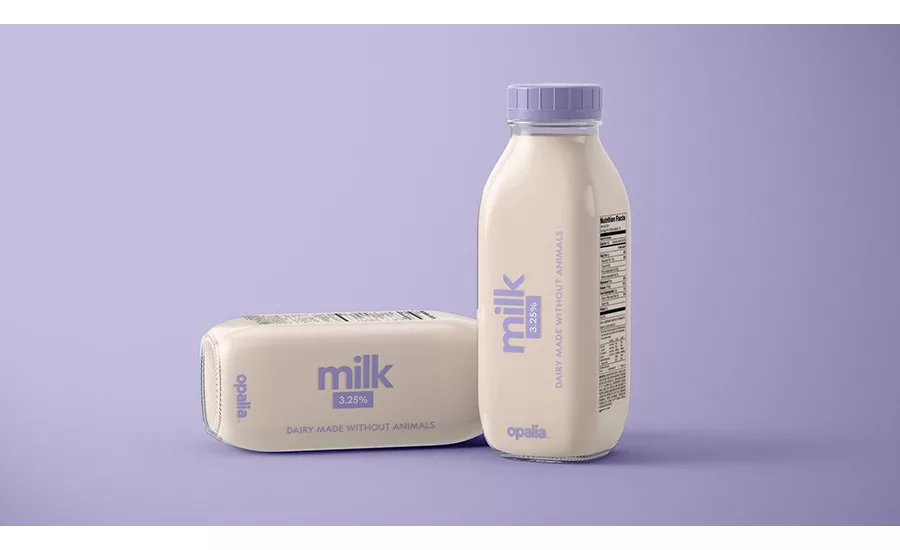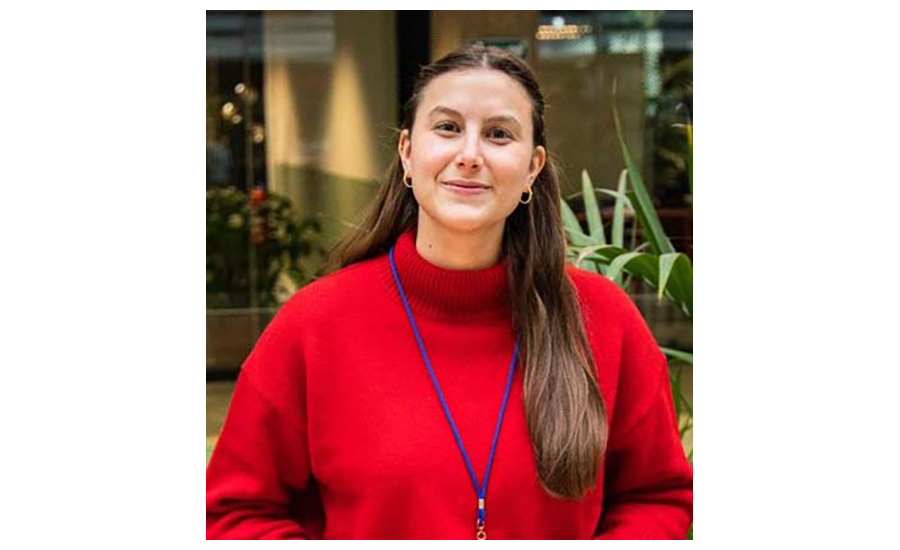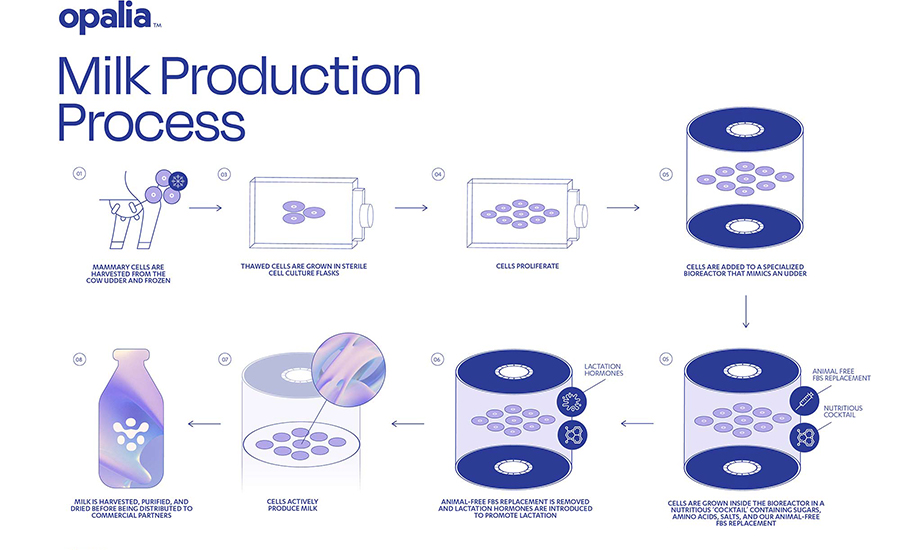Milk without the cow
Cell-based meats have grabbed the spotlight lately, but cell-based milk is receiving increased attention as startups get creative

Cell-cultured milk from Opalia Foods in its proposed retail packaging. The company is awaiting regulatory approval for sale to consumers. Photo courtesy of Opalia Foods
FOOD ENGINEERING has covered cell-based meats, seafood and even cocoa in recent years, and now several startups are vying for the creation of a cell-cultured milk process that delivers a product that tastes, smells, and performs like milk as an ingredient. One of those startups is Opalia Foods, based in Montréal, which has funding and industry support from CULT Food Science, Sustainable Food Ventures, and Big Idea Ventures.
Opalia’s process uses the cells responsible for lactation in cows. These cells are called mammary epithelial cells and are biologically engineered to make milk. The process recently reached a critical milestone on its path toward commercialization of animal-free cow’s milk—that is the elimination of fetal bovine serum (FBS) from its manufacturing process.
FBS is a commonly used component of synthetic cell growth and is extracted from the placenta of pregnant cows and is frequently used to cultivate cells and tissue outside of their normal environment. However, FBS is costly and subject to high levels of batch-to-batch variation that decreases its reliability. It can also easily be contaminated by harmful pathogens.
Why else should FBS be removed from the process? “By successfully replacing FBS with a cheaper, non-animal growth substrate that performs even better than FBS in our cell culture, we have reduced the cost and risk of manufacturing cell-based milk, bringing Opalia one step closer to introducing consumers to no-compromises, animal-free dairy,” says Jennifer Côté, co-founder and CEO of Opalia. “Our new replacement substrate enables Opalia to reliably cultivate mammary cell lines and thereby to cost-effectively scale up production of sustainable and animal-free milk to manufacture fully functional dairy products.”
Opalia was founded in September 2020 by Côté and Lucas House, vegans who wanted to do their part by limiting their impact on the planet, but didn’t like spending upwards of $13 for plant-based cheeses that they say had the consistency of plastic and tasted like lemon. Therefore, they set out on a mission to create a dairy alternative without the taste or feel of an alternative, with their goals being:
- The milk must look, taste, smell and perform just like real cow’s milk.
- It must employ a sustainable production process that does not involve animals.
- And—very important to drive adoption—it must cost no more than regular milk.
We contacted Côté to find out more about the process and Opalia.

— Jennifer Côté, cofounder and CEO of Opalia Foods
FE: Several startups are keen on developing a milk substitute, so what makes Opalia different?
Côté: Opalia is the only cell-based milk company focused exclusively on cow milk for traditional dairy applications like food, cosmetics and pharmaceuticals. Opalia has developed a patent-pending technology that allows us to reduce the cost of expensive lactation hormones by 4000×. Our competitive edge is that we are focused on reducing the costs early on with innovative technologies so that we can reach price parity at the launch of our milk product. Not only that, but we’ve proved that we are able to make the functional components of milk for identical taste and functionality.
FE: Some of your competitors have said they can produce specific functional components of milk or even human milk. Is Opalia’s strategy just to produce a complete milk product for retail consumption or as an ingredient for food processors?
Côté: Opalia is a B2B2C company that will supply milk and milk ingredients to companies in the food, cosmetics and pharmaceutical industries. By using mammary cells, which are made by nature to make milk, Opalia can make whole milk, a milk that has all of the constituents of traditional milk without the need for cows. Our milk performs just like real milk; it will foam, melt, bubble and emulsify in all your favorite dairy applications.

FE: Have you had any university help with your project or support of third parties such as CULT Food Science? If so, how have they helped?
Côté: Opalia has received the support of industry visionaries that include Big Idea Ventures, Sustainable Food Ventures, and CULT Food Science. They have been crucial to Opalia’s growth and have contributed to the advancement of our research and development in numerous ways. We are currently looking for more mission-driven partners and investors to help Opalia grow.
FE: How does your process work?
Côté: Opalia’s process involves harvesting mammary cells from the cow udder, then growing these cells in sterile cell culture flasks and making them proliferate in high numbers. Then the cells are added to a specialized bioreactor that mimics an udder, where they are given a nutritious “cocktail” containing sugars, amino acids, salts, and our animal-free FBS replacement. Once the cells are grown, the animal-free FBS replacement is removed, and lactation hormones are introduced to promote lactation. The cells then actively produce milk, and that milk is harvested, purified, and dried before being distributed to commercial partners.
FE: Are you able to control the final product in terms of, for example, butter fat and lactose?
Côté: Yes. We have full control over the end product because we have access to the milk-producing cell. Opalia’s milk can be dialed in to any desired specifications: we can include or remove lactose, and customize protein concentrations and fat percentages. The possibilities are endless.
FE: How energy-intensive is the process compared to a cow at production levels?
Côté: We are working on some partial life cycle assessments but don’t have the data yet. However, what I do know is that since our milk is developed without the need for cows, we produce significantly less greenhouse gas emissions, use less land and less water than the traditional dairy industry. Other alternative dairy companies have reported reduced water consumption of at least 96% and reduced greenhouse gas emissions of at least 97%.
FE: The U.S. FDA and the Canadian Food Inspection Agency (CFIA) will likely be the agencies setting food safety standards for these products. When do you think either agency will be ready for cell-based milk?
Côté: Opalia has been collaborating with the CFIA almost since our inception and it is really important for us to work in concert with regulating bodies to develop our technology and product in the safest way. Currently, cell-based meat companies are paving the way for cell-based milk companies by going through the process and obtaining approval and GRAS certifications for their product. Only when products are given regulatory approval can cell-based product be distributed to consumers. As for rules surrounding traditional cow’s milk, that will have to be established by the regulatory bodies.
FE: What about flavor and spoilage issues?
Côté: The flavor should be identical since we are able to make all of the functional ingredients of milk, like proteins, fats and sugars. As for spoilage, the method of production is sterile, so there are no bacteria introduced in our process. This means that our milk can be kept at shelf temperature for longer than traditional milk. Moreover, in large quantities, our milk is going to be dried for ease of shipping and storing, so there is even less worry about spoilage. The goal is to have a fully functional product in the powdered form even when reconstituted with water.
FE: How could the cost of cellular-based cow’s milk get competitive with the actual cow?
Côté: Our projections on reducing the costs of production indicate that we could attain price parity (less than $1.00/liter) at launch, and maybe even reduce the cost in the years following the establishment of the technology in the sector.
FE: How long will it take to get up to production-level quantities?
Côté: We expect to begin pilot-scale production of our milk and start distributing milk samples to partners for testing in 2023. Then, in 2024 or 2025, we will work on optimizing our milk production inside of different sizes of bioreactor to scale up the production to manufacturing levels.
FE: Consumers have sometimes been leery of products containing genetically modified components. How will you convince them that these products are wholesome and safe?
Côté: Our milk does not contain genetically modified components. We use genetic engineering on the mammary cells but it is separate from the end product that is sold to consumers. With the support of the different regulatory bodies, we will be able to ensure customers that our milk is 100% wholesome and safe.
FE: Are you looking for food industry partners?
Côté: Absolutely! We are always open for collaborations and to partnerships that can help us accelerate our research and development to get our product to market as fast as possible. We are in a state of climate urgency, and we need to move fast if we want our technology to limit the food industry’s impact on the planet.
Looking for a reprint of this article?
From high-res PDFs to custom plaques, order your copy today!







